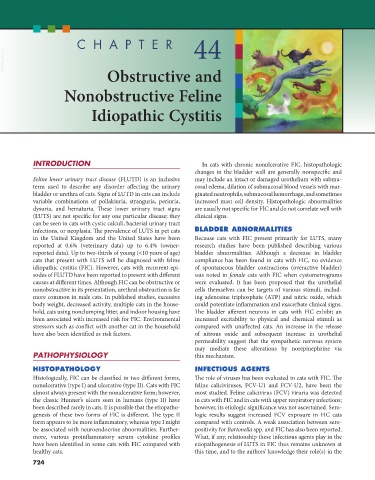Page 752 - Small Animal Internal Medicine, 6th Edition
P. 752
724 PART V Urinary Tract Disorders
CHAPTER 44
VetBooks.ir
Obstructive and
Nonobstructive Feline
Idiopathic Cystitis
INTRODUCTION In cats with chronic nonulcerative FIC, histopathologic
changes in the bladder wall are generally nonspecific and
Feline lower urinary tract disease (FLUTD) is an inclusive may include an intact or damaged urothelium with submu-
term used to describe any disorder affecting the urinary cosal edema, dilation of submucosal blood vessels with mar-
bladder or urethra of cats. Signs of LUTD in cats can include ginated neutrophils, submucosal hemorrhage, and sometimes
variable combinations of pollakiuria, stranguria, periuria, increased mast cell density. Histopathologic abnormalities
dysuria, and hematuria. These lower urinary tract signs are usually not specific for FIC and do not correlate well with
(LUTS) are not specific for any one particular disease; they clinical signs.
can be seen in cats with cystic calculi, bacterial urinary tract
infections, or neoplasia. The prevalence of LUTS in pet cats BLADDER ABNORMALITIES
in the United Kingdom and the United States have been Because cats with FIC present primarily for LUTS, many
reported at 0.6% (veterinary data) up to 6.4% (owner- research studies have been published describing various
reported data). Up to two-thirds of young (<10 years of age) bladder abnormalities. Although a decrease in bladder
cats that present with LUTS will be diagnosed with feline compliance has been found in cats with FIC, no evidence
idiopathic cystitis (FIC). However, cats with recurrent epi- of spontaneous bladder contractions (overactive bladder)
sodes of FLUTD have been reported to present with different was noted in female cats with FIC when cystometrograms
causes at different times. Although FIC can be obstructive or were evaluated. It has been proposed that the urothelial
nonobstructive in its presentation, urethral obstruction is far cells themselves can be targets of various stimuli, includ-
more common in male cats. In published studies, excessive ing adenosine triphosphate (ATP) and nitric oxide, which
body weight, decreased activity, multiple cats in the house- could potentiate inflammation and exacerbate clinical signs.
hold, cats using nonclumping litter, and indoor housing have The bladder afferent neurons in cats with FIC exhibit an
been associated with increased risk for FIC. Environmental increased excitability to physical and chemical stimuli as
stressors such as conflict with another cat in the household compared with unaffected cats. An increase in the release
have also been identified as risk factors. of nitrous oxide and subsequent increase in urothelial
permeability suggest that the sympathetic nervous system
may mediate these alterations by norepinephrine via
PATHOPHYSIOLOGY this mechanism.
HISTOPATHOLOGY INFECTIOUS AGENTS
Histologically, FIC can be classified in two different forms, The role of viruses has been evaluated in cats with FIC. The
nonulcerative (type I) and ulcerative (type II). Cats with FIC feline caliciviruses, FCV-U1 and FCV-U2, have been the
almost always present with the nonulcerative form; however, most studied. Feline calicivirus (FCV) viruria was detected
the classic Hunner’s ulcers seen in humans (type II) have in cats with FIC and in cats with upper respiratory infections;
been described rarely in cats. It is possible that the etiopatho- however, its etiologic significance was not ascertained. Sero-
genesis of these two forms of FIC is different. The type II logic results suggest increased FCV exposure in FIC cats
form appears to be more inflammatory, whereas type I might compared with controls. A weak association between sero-
be associated with neuroendocrine abnormalities. Further- positivity for Bartonella spp. and FIC has also been reported.
more, various proinflammatory serum cytokine profiles What, if any, relationship these infectious agents play in the
have been identified in some cats with FIC compared with etiopathogenesis of LUTS in FIC thus remains unknown at
healthy cats. this time, and to the authors’ knowledge their role(s) in the
724

